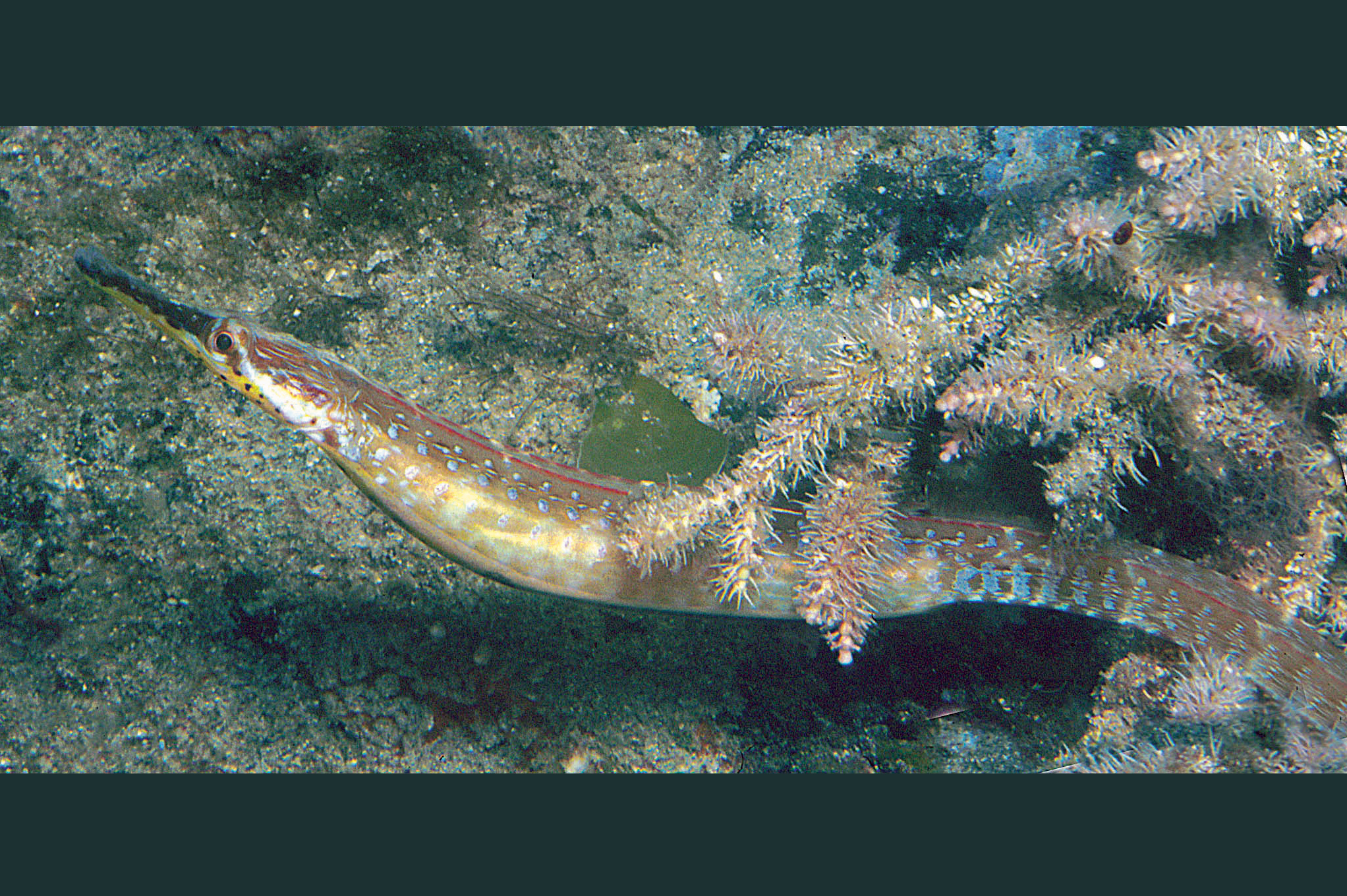- Classification
- ACTINOPTERYGII
- SYNGNATHIFORMES
- SYNGNATHIDAE
- Vanacampus
- poecilolaemus
Longsnout Pipefish, Vanacampus poecilolaemus (Peters 1868)

Longsnout Pipefish, Vanacampus poecilolaemus. Source: Rudie H. Kuiter / Aquatic Photographics. License: All rights reserved
A pale brown pipefish with 6–9 rows of small dark-edged ocelli on the side of the trunk; side of snout with faint diagonal pale bars or blotches in adult males, distinct dark bars and spots in adult females.
Longsnout Pipefish, Vanacampus poecilolaemus (Peters 1868)
More Info
|
Distribution |
Endemic to temperate waters of southern Australia, from east of Flinders Island, Bass Strait, Tasmania, and Wilsons Promontory, Victoria in the east, to Cottesloe, Western Australia. Inhabits shallow seagrass and macroalgal beds in estuaries and other quiet, silty, clear-water areas to about 18 m. |
|
Features |
Dorsal fin 25–31; Pectoral fin 11–14; Anal fin 3–4; Caudal fin 10; trunk rings 18–20 (usually 19); tail rings 44–51; subdorsal rings 1.75–0.50 + 5.00–6.75 = 6.25–8.00 Body elongate, trunk shallow; head aligned with body; snout moderately long, length 45–63% HL, depth 10–20% snout length; median dorsal snout ridge not confluent with supraorbital ridge; longitudinal opercular ridge usually complete; superior trunk and tail ridges discontinuous near rear of dorsal-fin base; inferior trunk and tail ridges continuous; lateral trunk ridge not confluent with tail ridges; tail not prehensile.
Dorsal fin slightly closer to tip of snout than to tip of tail, base of moderate length; anal fin tiny, below anterior portion of dorsal fin; caudal fin small. |
|
Size |
To more than 30 cm. |
|
Colour |
Pale brown with 6–9 rows of small dark-edged ocelli laterally on trunk; side of snout with faint diagonal pale bars or blotches in adult males, distinct dark bars and spots in adult females. |
|
Feeding |
Adults feed on small crustaceans sucked in through the long tubular snout. Mysid shrimps are an important food source for juveniles. |
|
Biology |
Males brood the eggs in an enclosed pouch on the underside of the tail just behind anal fin; males may be brooding at 170 mm SL. Approximately 40–50 eggs are deposited in the pouch in a single layer of 2–4 transverse rows. Body rings are present in larvae at an early stage; anal fin is reduced. |
|
Fisheries |
|
|
Conservation |
Australian Commonwealth legislation: Marine listed under the Environment Protection and Biodiversity Conservation Act 1999 (EPBC Act 1999). Listed as protected under the Victorian, Tasmanian and South Australian Fisheries Management Acts. |
|
Remarks |
Near Fremantle, Western Australia, the Longsnout Pipefish was nearly always found in the seagrass Posidonia sinuosa. |
|
Similar Species |
The Longsnout Pipefish can be distinguished from other species of Vanacampus by its very long snout and large maximum size (27 cm SL versus 18.4 cm SL). |
|
Etymology |
|
|
Species Citation |
Syngnathus poecilolaemus Peters 1868, Monatsberichte der Königlichen Preussischen Akademie der Wissenschaften zu Berlin 1868: 458. Type locality: Adelaide, South Australia. |
|
Author |
Bray, D.J. & Thompson, V.J. 2018 |
|
Resources |
Longsnout Pipefish, Vanacampus poecilolaemus (Peters 1868)
References
Dawson, C.E. 1978. Syngnathus parvicarinatus, a new Australian pipefish, with notes on S. sauvagei (Whitley) and Leptonotus caretta (Klunzinger). Copeia 1978(2): 288-293 figs 1-2
Dawson, C.E. 1984. Synopsis of Australian pipefishes usually referred to the syngnathine (tail-pouch) genera Syngnathus, Leptonotus and Histiogamphelus. Memoirs of Museum Victoria 45: 71-123 [Plates 1-9]
Dawson, C.E. 1985. Indo-Pacific Pipefishes (Red Sea to the Americas). Ocean Springs (Mississippi) : Gulf Coast Research Laboratory 230 pp. 293 figs pl. 1.
Dawson, C.E. 1994. Family Syngnathidae. pp. 440-475 figs 391-426 in Gomon, M.F., Glover, C.J.M. & Kuiter, R.H. (eds). The Fishes of Australia's South Coast. Adelaide : State Printer 992 pp. 810 figs.
Glover, C.J.M. 1983. Freshwater and marine fishes. pp. 157-167 figs 1-2 in Tyler, M.J., Twidale, C.R., Ling, J.K. & Holmes, J.W. (eds). Natural History of the South East. Adelaide : Royal Society of South Australia.
Kuiter, R.H. 1993. Coastal Fishes of South-eastern Australia. Bathurst : Crawford House Press 437 pp.
Kuiter, R.H. 2000. Seahorses, Pipefishes and Their Relatives. Chorleywood, UK : TMC Publishing 240 pp.
Kuiter, R.H. 2008. Syngnathidae. pp. 448-479 in Gomon, M.F., Bray, D.J. & Kuiter, R.H. (eds). Fishes of Australia's Southern Coast. Sydney : Reed New Holland 928 pp.
Kuiter, R.H. 2009. Seahorses and their relatives. Seaford, Australia : Aquatic Photographics pp. 331.
Last, P.R., Scott, E.O.G. & Talbot, F.H. 1983. Fishes of Tasmania. Hobart : Tasmanian Fisheries Development Authority 563 pp. figs.
McCulloch, A.R. 1912. Notes on some Western Australian fishes. Records of the Western Australian Museum 1(2): 78-97 figs 1-2 pls 9-13 (as Corythoichthys poecilolaemus)
McCulloch, A.R. & Whitley, G.P. 1925. A list of the fishes recorded from Queensland waters. Memoirs of the Queensland Museum 8(2): 125-182
Peters, W.C.H. 1868. Über eine neue Nagergattung Chiropodomys penicillatus, so wie über einige neue oder weniger bekannte Amphibien und Fische. Monatsberichte der Königlichen Preussischen Akademie der Wissenschaften zu Berlin 1868: 448-460 figs 1-2
Sauvage, H.E. 1879. Description de quelques poissons d'espèces nouvelles de la collection de Muséum d'Histoire Naturelle. Bulletin de la Société Philomathique de Paris 7 3: 204-209 (as Syngnathus modestus)
Waite, E.R. 1921. Illustrated catalogue of the fishes of South Australia. Records of the South Australian Museum (Adelaide) 2(1): 1-208 293 figs pl. 1
Whitley, G.P. 1929. Studies in Ichthyology No. 3. Records of the Australian Museum 17(3): 101-143 figs 1-5 pls 30-34 (as Corythoichthys sauvagei)
Whitley, G.P. 1948. A list of the fishes of Western Australia. Western Australia Fish Department. Fisheries Bulletin 2: 1-35 map (as Parasyngnathus poecilolaemus)
Whitley, G.P. & Allan, J. 1958. The Sea-horse and its Relatives. Melbourne : Georgian House 84 pp. 25 figs. (as Parasyngnathus sauvagei)


